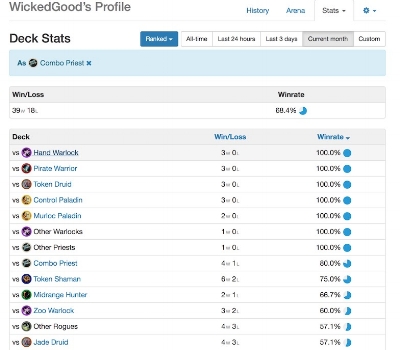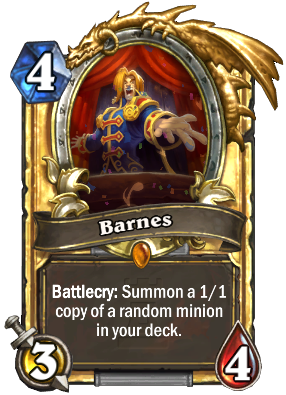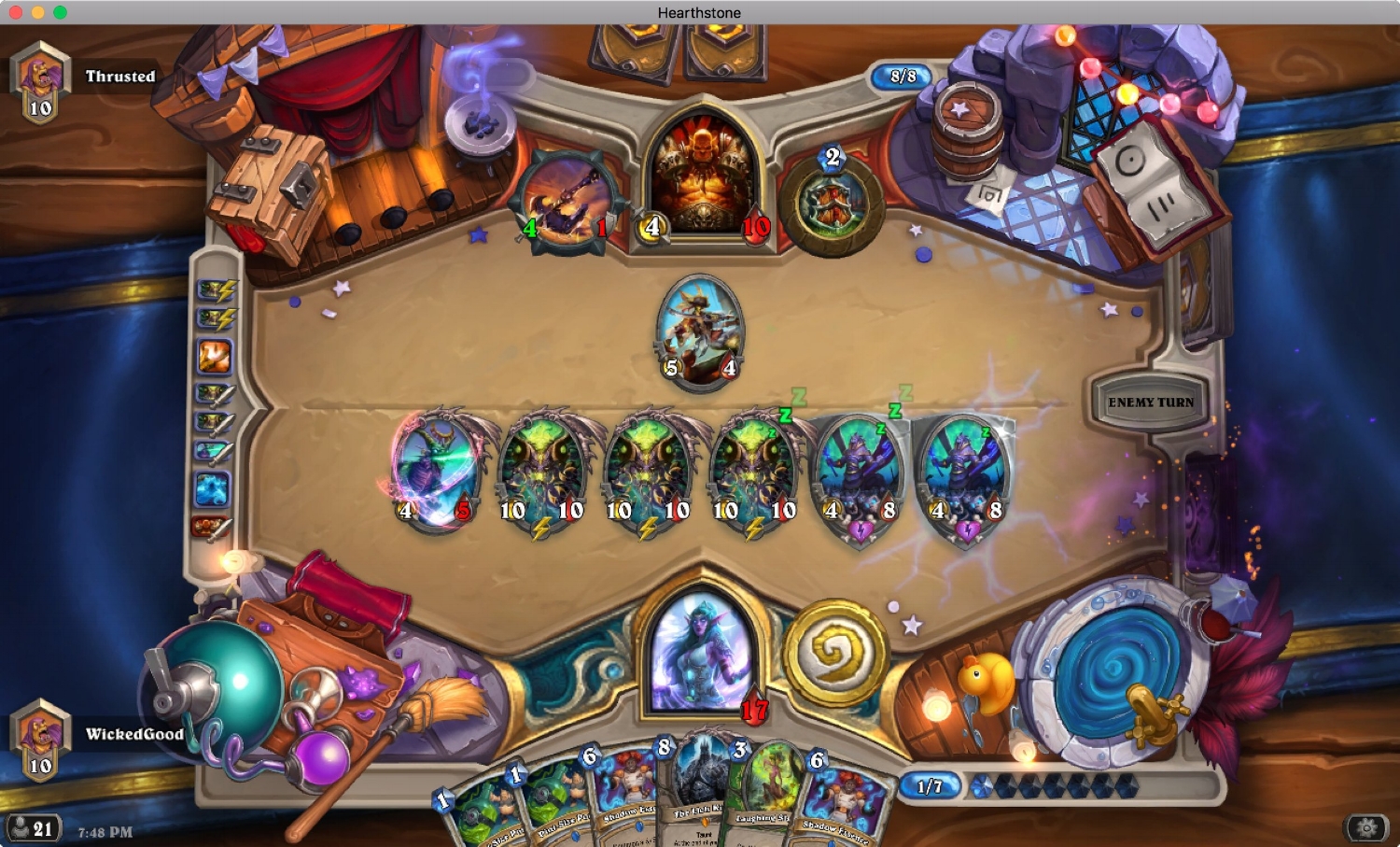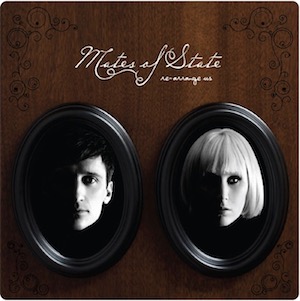“Tonight! A tale of terrible tragedy!” (For your opponent, that is!)
Why go big?
Because you like posting “don’t talk to me or my son ever again” memes on Twitter, obviously. Also because you’re skilled at drawing Barnes.
Don't talk to me or my son ever again.
All joking aside, I honestly believe Big Priest is well positioned against nearly everything in the meta right now. The reason that the deck gets dismissed as a meme deck is the presence of Barnes and Y’shaarj. To be sure, games where Barnes pulls a skinny Y’shaarj, who in turn pulls a full-fat Y’shaarj, will definitely happen, but that’s not how you win most games. In fact, overvaluing Barnes is why most people who play the deck struggle at first, and why many just give up on it.
Here’s the sneaky thing about Big Priest. This is Control Priest in meme deck’s clothing. If you ignore Barnes and focus on what the rest of the deck is composed of, you have five giant minions which serve as your eventual win conditions, cards that exist to cheat out or resurrect those minions, and the rest of the deck is made up of a pile of removal and control tools. A LOT of removal and control tools. And that’s the key to the deck. Once you stop focusing on trying to cheese out early wins and use Barnes and Shadow Essence to develop into board control instead, your win rate will go up dramatically. In other words, this is a control deck with the potential to high roll some wins, not a deck that has a high roll combo and a bunch of cards that help you survive until you find it (if you even draw the cards in the right order.)
So why should you play this instead of Highlander (Raza/Kazakus/Anduin) Priest? One word: Consistency. Yes, that’s right, this “meme deck” is often more consistent in terms of controlling the game and then closing it out than Highlander. Decks like Tempo Rogue and Zoo often demand specific answers to specific board states; running an overwhelming number of removal spells, as well as running two copies of most of them, ensures you’ll probably have some sort of answer for nearly every early board state in time to stabilize and start dropping bombs of your own. Highlander’s weakness is running a large variety of one-ofs; it’s very easy to draw into the wrong cards for a dire situation, or have one of the specific combo pieces at the bottom of your deck, forcing you to exhaust additional resources to survive long enough to find it. It’s also worth stating that Highlander’s popularity helps you as a Big Priest player; until you’ve shown Barnes or Shadow Essence, your opponent will likely be working under the assumption that, once you’ve played a card, they don’t need to play around it again for the rest of the game. In the case of your strong board clears like Dragonfire Potion or Shadow Word Horror, that sometimes will lead your opponent to overextend into the second copy of one of those cards, giving you a significant advantage.
Stats from this month's climb from ranks 15-5.
Why Should You Listen to Me?
I climbed from Rank 4 to Legend over a weekend with Big Priest In September with a 62% win rate. I’ve put in another 50+ games with the deck over October, and I’m already at Rank 5 as of October 5th, using Big Priest almost exclusively from rank 15 (aside from some experiments with other decks at floor ranks).
Card Choices
Deck code: AAECAZ/HAgiiCaUJ1gqoqwKFuAK3uwLCzgKQ0wILlwLTCtcKoawCtbsC6L8C6r8C0cEC5cwC5swCtM4CAA==
Silence: Being able to handle a problematic minion’s text or buffs while also addressing the rest of the board is useful. Don’t forget that you can silence the 1/1 from your Barnes to get a full sized minion if you need the board presence, or if you’re concerned the 1/1 might get stolen via Potion of Madness.
Holy Smite: Good for addressing early minions without spending a more premium removal, or clearing a 6 or 7 health minion along with Dragonfire. Can also be used late game with Anduin for burst damage.
Pint-Sized Potion: A surprisingly flexible card. Most often paired with Shadow Word Horror as a board clear, but can also be used to get a larger minion into Pain/Potion of Madness range, preserve health on your minions while trading, or as fuel for Anduin’s hero power.
Potion of Madness: Good early answer to pirates and early Hunter boards, as well as Raza priest’s early card draw minions. Can also be used to pull a small taunt out of the way to get in face damage late.
Shadow Visions: The general rules apply; try to use this to find specific answers, ideally once you’re sure what you’re playing against, but tossing it out on 2 against a known opponent’s deck is fine too. When in doubt, take Essence or Servitude. Grabbing extra copies of board clears is usually fine too.
Shadow Word: Pain: Good single target removal. Remember that larger minions can be shrunk with Pint Sized Potion to get into Pain range in a pinch.
Shadow Word: Death: Good single target removal. Note that one uncommon interaction that’s good to be aware of is that you can use Nightmare from Ysera to get a smaller minion into Death range.
The award for Best Supporting Actor goes to...
Barnes: Playing the (high) role of Prince Keleseth. Your win rate when you play Barnes on curve goes up dramatically; feel free to just slam him as soon as possible. If you pull him later in the game, consider which minions are still left in your deck and try to play him when one of those minions would be most advantageous to you.
Eternal Servitude: The strongest card in the deck once you’ve gotten a minion down. Just be careful if you’ve used Potion of Madness liberally; the resurrect pool may have fewer usable options than you’d like. That said, I don’t think I’ve ever played Servitude and not had a usable pick.
Greater Healing Potion: Sometimes you just need to heal for 12.
Mass Dispel: With all the cards that provide buffs to minions (Murlocs, Keleseth, Cobalt Scalebane, Mark of the Lotus, etc.), being able to reset a board that is getting out of control is valuable.
Shadow Word: Horror: One of the most underrated cards in Priest up until this expansion. This usually gets fine value on its own, and paired with Pint Sized Potion is your only clean answer to 4-attack minions outside of lucky deathrattles from Obsidian Statue.
Dragonfire Potion: Your most premium removal. You have lots of options and two copies of this card, so you can be a little less stingy with this than when playing Highlander Priest, but still try to save it for boards where it will make the biggest impact. Also remember that the “except dragons” part is occasionally relevant, most often when you have Ysera or your opponent has Cobalt Scalebane.
Shadow Essence: One of the obvious drivers of the deck, because it cheats out a big minion that you can resurrect. One key misplay many people make with this deck is going all in on this card when they shouldn’t. If Barnes hasn’t been drawn, you’re effectively playing Russian Roulette when you play Essence, which is fine if you know the percentages; every minion you’ve drawn increases the odds that the pull will be Barnes dramatically. With all your minions in the deck, the odds are 17% that you’ll pull Barnes; if you’ve drawn 3, it goes up to 33%, and with 4 drawn it’s a coin flip. When you’re behind on board on turn 6, understanding how likely you are to get a minion with taunt as opposed to Barnes, especially if you have other removal options to choose from, is key to success with this deck. Don’t just blindly go into Essence on 6 every time because it’s not always correct.
His friends call him "Shadow Word: Megadeth".
Shadowreaper Anduin: We’re playing a priest deck in 2017 so we’re playing Anduin. This isn’t our primary win condition like in Highlander Priest, but the ability to wipe a large board (especially against Jade Druid and responding to Bonemare turns) and get enough damage to close out close games makes him worth including. Just keep in mind that Anduin wipes out your big minions also, so try not to play him with Lich King or Y’shaarj on board.
The Lich King: A big taunt who generates immediate card advantage. Most death knight cards are self explanatory, but a note on Army of the Dead: If most of your minions are still in your deck, especially if your Eternal Servitudes are gone, this can be an ok play when you’re behind to get board presence. Just calculate your odds first. Also, Doom Pact can be played on an empty board if you just need space in your hand.
Obsidian Statue: Easily the reason you’re playing the deck in the first place. Healing plus removal plus taunt all in one. You’re usually going to play this as a stall or emergency heal, but don’t underestimate the capability of Statue to set up a board clear. Very often the response from your opponent will be to go wide on the board to try to protect their threats from the Statue’s deathrattle. If you can follow this up with a board clear, you can often buy yourself a bunch of time to stabilize. Statue into Dragonfire is very effective in clearing out problematic minions with more than 5 health.
Ysera: Probably the weakest minion on its own because she provides card advantage but doesn’t directly affect the board on the turn she comes out. That said, Ysera sticking for several turns can provide late game burst via Nightmare and Ysera Awakens, as well as soft removal via Dream and additional minion pressure. Keep in mind that Dream can be used to remove a taunt to create lethal, Nightmare can be used to get a smaller minion into Shadow Word Death or Anduin range, and the 7/6 is immune to Dragonfire Potion.
Y'Shaarj, Rage Unbound: If you’re tracking the cards in your deck correctly you should generally have a good idea of what Y’shaarj can pull out when played from hand. In most decks he’s dangerous to play on his own, but here he’s fairly likely to bring a big taunt along for the ride. And it goes without saying that Barnes into Y’shaarj ends some games before they start.
Don't expect this to happen every game, but it's fun when it does.
Substitutions
The six minions, Shadow Essence and Eternal Servitude are core to the deck and cannot be cut without significantly affecting your win rate. It’s true that this is a fairly expensive deck and the minions are all epic or legendary, but they work because they immediately impact the board when they’re summoned via Barnes/Essence/Servitude. If you’re missing one and want to try the deck out to see if it’s worth investing dust in, look for minions that cost more than 7 mana that have some sort of continuous/end of turn effect, or deathrattle. Nozdormu, Charging Devilsaur, and Gruul are all minions that have popped into “budget” versions of this deck, and there is also a Malygos/Velen build that requires a different mix of spells.
As far as the non-summoning spells go, feel free to adjust the list based on your local meta. Some cards that occasionally see play in the list include Forbidden Shaping and Free From Amber for additional minion generation, Mind Vision and Thoughtsteal to provide more early game options without putting bad Barnes/Essence minion targets into the deck, and you could consider Holy Fire or even Mind Control if you find you’re running into problematic minions like Cobalt Scalebane or Primordial Drake that you can’t clear otherwise.
Mulligans
This is the most important part of playing Big Priest. Mulligans are important in every deck, of course, but mulliganing incorrectly with Big Priest is usually the reason why you’ll end up losing a lot of games because you have minions clogging up your hand and no answers to the board. The mulligan is more or less the same regardless of matchup, and the general rule is incredibly simple:
Pitch minions. Keep spells. That’s it.
Ok, there’s a bit more to it than that, but that’s the general rule. Note that you do not hard mulligan for Barnes ever. Not against Priest. Not against Druid. Not ever.
As stated in the intro, the way you lose with this deck is overvaluing Barnes. The truth is that, as good as Barnes is on curve (and yes, the win rate with him in your opening hand is something between 70 and 75%), there are five other minions in the deck and all of them are universally terrible to get in your opening hand because they’re dead cards for at least eight turns, and they limit your possible results from Barnes and Shadow Essence. The odds of drawing one of those minions by throwing spells back is significantly higher than the odds of getting Barnes, and the potential upside of drawing Barnes is outweighed by drawing any other minion. This doesn’t guarantee you won’t draw your other minions, but mulligans are always about percentages and never guarantees.
This is not a winning hand.
So, maybe I’ve convinced you and maybe I haven’t, but your next likely question is, “But what if I’m stuck with a bunch of spells that don’t look useful for what I’m facing? Don’t I want Potion of Madness against Hunter every time?” Sure, you want it, but you don’t need it. You run so much removal in this deck that you’re likely to draw into the cards you need by the time you need them. For instance, let’s say you’re really worried about Vicious Fledgling. You run a Silence, two Shadow Word Pains, and a Mass Dispel, and those are just the single card answers to it not including two card combos. You sometimes need to be creative with combining removal for specific board states, but trust the deck to give you what you need.
In general, pitch minions (and Shadowreaper Anduin) and keep spells. Eternal Servitude is the only spell you should throw back if you don’t have Barnes in hand already, because it’s as dead as the minions until you get a rez pool. If you get Barnes in the initial mulligan stage, feel free to hard mulligan for Eternal Servitude and keep whichever spells you got that seem useful in keeping the board under control until you can drop Barnes.
Tips for Specific Matchups
Priest - Even
- If you can, Silence or Smite the 1/1 from Barnes if you haven’t seen Potion of Madness yet. Against Raza this shouldn’t keep you from playing Barnes, but if your opponent has done nothing yet and you suspect it could be a mirror match, there’s not too much harm in waiting a turn or two to set that up. Giving your opponent an extra minion in their rez pool, especially if they have Servitude in hand, can lose you the game on the spot.
- Don’t play Y’shaarj from hand until you’ve seen Anduin from your opponent if Lich King is still in your deck. Giving your opponent a 2-for-1 while pulling that minion out of your deck can be a swing that you can’t recover from.
Rogue - Slightly Favored
- The early game comes down to who can high roll who first.
- Try to save Anduin for a Bonemare turn; you’ll take out the Mare and the target at once.
- Make sure to calculate potential burst into your turn planning. Many rogue decks run Blazecallers or some combination of Leeroy, Shadowstep and Cold Blood. Leeroy + Shadowstep + Cold Blood = 16 damage.
- Silences are key to address huge Edwins or Bonemare targets.
Warlock - Slightly Favored
- Try to save your Deaths for Doomguards; none of your other removals are very effective against them.
- Make sure to hold back a board clear for the Gul’Dan turn.
- Potential burst usually comes in the form of Doomguard, Bonemare and Soulfire, plus Doomguards that will get resurrected by Gul’Dan past turn 10, so be sure to factor that in when deciding whether or not to clear.
- In general against zoo, if you can get value from your board clears and have answers for Doomguards, you should be able to run them out of resources eventually.
Shaman - Favored
- This matchup is pretty straightforward; they need a board to win and you have clears for days. You can more or less ignore anything that isn’t a Mana Tide or Flametongue for the first several turns, since an early Evolve is actually good for you, and you don’t have to worry about Bloodlust until turn 5. That said, there’s nothing wrong with using a Potion of Madness early to clear out a couple of 1/1s.
- Once they can Bloodlust, you should always be counting their damage to decide if you need to address a board or not. One of the strongest plays you can make is to not clear on turn 4 or 6 when you’re not at risk of lethal, let your opponent overextend, and then get additional value from the board clear the following turn.
- In general, you want to use Horror to clear non-Evolved boards and save Dragonfire for post-Evolve. After you clear a couple of times you can usually just grind the Shaman out of resources and either beat them down with your big minions or just wait for them to concede.
Friends don't let friends use Devolve against Big Priest.
Hunter - Favored
- Try to save your board clears for when you see a Bearshark or a Hyena; either of those minions can get out of hand quickly and it can be difficult to deal with them. Similarly, if you have Silence try to hold it for Highmane.
- As long as the hunter doesn’t get a ridiculous opening this matchup is pretty winnable; just keep clearing until you can get one or two big minions down and you should be able to grind them out of resources as long as they don’t run Rexxar.
Warrior - Favored?
- I’ve seen very few warriors post nerf, but most of what I’ve seen has been modified pirate warrior. Follow the same guidelines as the other matchups, but your threshold for when to board clear is much lower since pirate warrior doesn’t go as wide. Your taunts are often better than Oozes at removing weapons.
Paladin - Favored
- Most paladins are Murloc; Silence handles Warleader in absence of pain, and if you can catch a Megasaur in the first board clear you should be ok.
- Mass Dispel is a good substitute for a board clear in a pinch; paladin is so dependent on tribal synergies that it can cut a big board down to size quickly.
- If you can, hold Silence for Tirion late, and having a board clear in reserve for Tarim usually clinched the game.
Mage - Unfavored
- Every version of Mage is a difficult matchup.
- Try to hold Barnes for when a Secret is on board; that’s your only way to test for mirror entity. Pint sized Potion and Holy Smite are good spells to hold to test for Counterspell.
- Against quest and Control Mage, you basically go as aggro as you’re able and try to beat them before they get their draws. Remember that Silence can unfreeze a minion in a pinch.
Druid - Even
- Your goal here is to build up enough pressure before they can get their UI online; any turn where they have to address your board is a turn they’re not ramping mana.
- Make sure to figure their armor into your turn planning, especially once they have Malfurion online. Feral Rage and Earthen Scales are worth considering also.
- You absolutely want to hold Anduin as long as you’re able; it’s your only way to clear a board of huge jades once they get out of Dragonfire range. Similarly, you want to try to use Shadow Word Horror to clear the early boards and save your Dragonfires for the mid-sized boards, since it will be hard to get value out of Horror once the jades start ramping up.
- If you do draw Horror toward the late game, save it for spiders from Malfurion or Spreading Plague. That can sometimes create lethals you wouldn't have otherwise.
- If you’re mulliganing for spells you should be fine if your opponent turns out to be Aggro Druid. Just hold a Death for Bittertide Hydra and hold a board clear in reserve to handle Living Mana. Usually the game ends once you clear followed by dropping a big taunt.
Go Get Big!
Big Priest may not be a meme deck, but it’s got good matchups against nearly everything in the meta, is really consistent once you learn to play it, and honestly, it’s just a blast to play. Don’t let the occasional Shadow Essence into Barnes dissuade you from dominating your opponents with statues and dragons and undead knights for days.
If you like this content, please consider subscribing to my weekly podcast, Off Curve, where I talk about Hearthstone while driving home on my commute. You can find it in iTunes and on Google Play. Thanks for reading!














